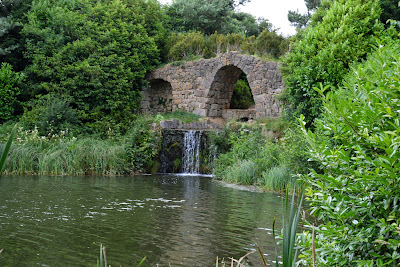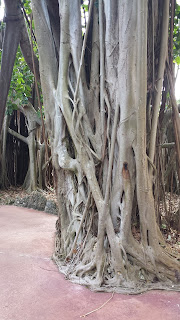Ha-has (Recessed walls)
This landscape design element can be found near the area surrounding the Washington Monument in Washington, D.C.
The Ha-has wall creates a vertical boundary impediment while sustaining a continuous and unbroken (without obstructing) view of the landscape from afar. The design incorporates a incline which slopes downward to a vertical wall (masonry retaining wall).


Washington Monument
Parco de Mostri
Bomarzo, in the province of Viterbo, northern Lazio, Italy
16th Century
 L'Orco Classico
L'Orco Classico
Roman Forum
The Roman Forum was designed by the architect Vitruvius
Rome, Italy


Boboli Garden
Architects: Giorgio Vasari, Bernardo Buontalenti, Niccolò Tribolo, Bartolomeo Ammannati
Florence, Italy


Ragnaie (spiders lane)
Jardin du Luxembourg
Inspired by the Boboli Gardens in Florence, were created upon the
initiative of Queen Marie de Medici in 1612.
Paris, France


Tivoli Garden
T
erraced gardens designed in 1550 by architect
Pirro Ligorio for the governor Cardinal Ippolito II d’Este
Tivoli, Lazio, Italy



Bernini's Four Rivers
designed in 1651 by Gian Lorenzo Bernini for Pope Innocent X
Piazza Navona in Rome, Italy


Jean Dubuffet's Jardin d'Emaille
Epoxy resin and concrete with polyurethane paints
Made in 1974
Collection: Rijksmuseum Kröller-Müller, Otterlo (Netherlands)


Stowe Garden
The
landscape garden at Stowe is one of the most remarkable legacies of Georgian
England. Created by Viscount Cobham in the grounds of his family home from
1717, it reflected a programme of ideas based on Cobham’s hugely influential
network of political affiliations.
Buckinghamshire, England

.JPG)

Stourhead Garden
When
Stourhead first opened in the 1740s, a magazine described it as ‘a living work
of art’. The world-famous landscape garden has at its centrepiece a magnificent
lake reflecting classical temples, mystical grottoes, and rare and exotic
trees, and offers a day of fresh air and discovery.
Stourhead
is a 1,072-acre estate at the source of the River Stour near Mere, Wiltshire,
England. The estate includes a Palladian mansion, the village of Stourton,
gardens, farmland, and woodland. Stourhead is part owned by the National Trust
since 1946.
Wiltshire,
England


Vizcaya Museum
Vizcaya
was created as James Deering’s subtropical winter home in the 1910s and today
it is a National Historic Landmark and accredited museum.
Vizcaya
Museum and Gardens is a National Historic Landmark that preserves the Miami
estate of agricultural industrialist James Deering to engage our community and
its visitors in learning through the arts, history and the environment. James
Deering chose the location of Vizcaya because he was attracted to the warm
weather and hoped it would improve his health.
Paul
Chalfin was not a trained architect and, in 1912, Deering hired Francis Burrall
Hoffman, Jr. (1882–1980) as Vizcaya’s architect of record.
Hoffman developed the
plan of the Main House, creating a spatial framework for the decorative
elements and artwork that Chalfin and Deering had already collected.


Fairchild Tropical Garden
Fairchild Tropical Gardens gets its name from one of
the most famous plant explorers in history, David Fairchild (1869-1954). Dr.
Fairchild was known for traveling the world in search of useful plants, but he
was also an educator and a renowned scientist.
The botanical garden is located in Miami because it is
the one place in the continental United States, where tropical plants could
grow outdoors year-round. Opened to the public in 1938, Fairchild Tropical
Botanic Garden was established on an 83-acre site south of Miami.
Miami, Florida


When the author says every garden is a replica he
means that a garden is a representation or an attempt to recapture an image.
The garden is a replica of the natural environment as another image of art.
The two poles of gardening are formal gardens and
irregular English gardens. The two poles of gardening relate to the gardens of
Versailles because the garden depicts two different styles of gardening
occurring at the same time creating a juxtaposition within the realm of
gardening to demonstrate the approaching Revolution in France. The elephantine
stasis or massive and immense state of inactivity shares the grounds with the
butterfly charm of the Marie Antionette’s hameau’s natural English garden landscape,
a reflection of France's cultural values on the evening before the Revolution.
A feature to describe the Versailles garden is still
geometrical without edges, without the figure’s being closed at the far end,
the lines ruled but stretching off to infinity. This type of garden starts
narrow and go one to become suggestively wide. Despite the freedom at the other
end, it is the most rigidly organized of all, imitating a reasoned progression
from small to large.
In contrast, the other kind of boundless garden is not
a geometrical figure at all. The English kind of garden has no obvious
beginning or end and the bounds are confused on all sides, so that for this
garden an un-wall had to be invented. The sunken fence is an English joke on
law and order that exercises real constraint with the imaginable English
deviousness.
I find that the communities of home property
developments and apartment complexes near the city of Doral, in Miami Florida
are very picturesque because they are very pretty, attractive, pictorial
qualities which refer to the modernization of landscape and architecture of the
constructed homes. They all generally have the same layout inside,
inside/outside color, and materials used to construct the home which takes away
the originality leading to the home later becoming boring and unpleasing to the
eye to look at.
A familiar place to me with a landscape within it is
Coral Reef Park. The park is located by the Coral Reef suburban home community.
My relationship towards this park, this is the park where to go to exercise
with my best friend Amarys and her sisters under the gazebo. This park
represents friendship, peacefulness, health, beauty within nature, community,
respect for nature, family and love.

































.JPG)




